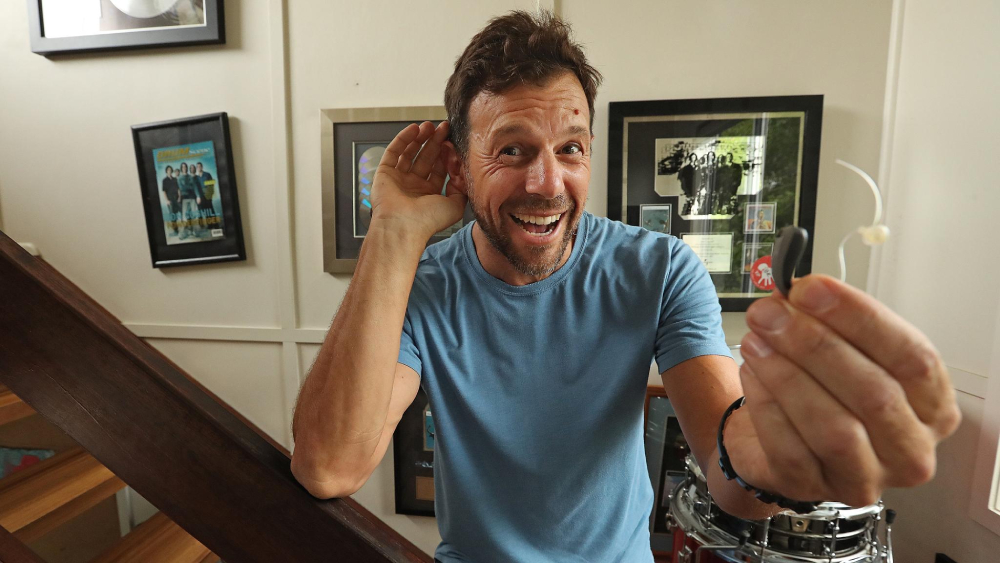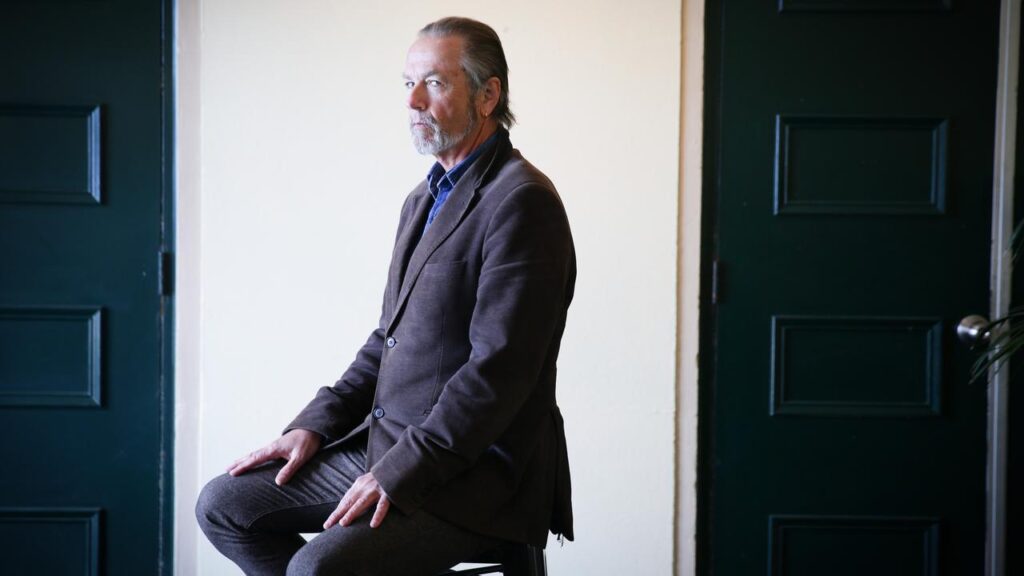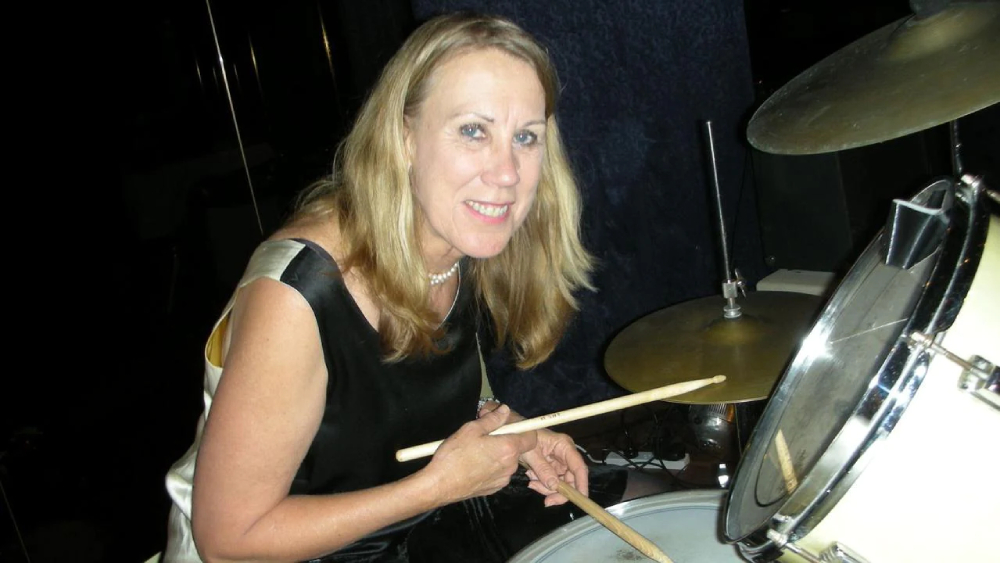The Sound Barrier
Hearing loss is a silent occupational hazard for musicians.
March 3rd, 2018

Jon Coghill, former drummer of Powderfinger, who has hearing loss from his days on stage. Picture: Lyndon Mechielsen
On a sunny Saturday afternoon in late January, a musician called Steve Kilbey is visiting Brisbane. Everywhere he goes, he carries with him something that nobody else can see, and that only he can hear.
In a couple of hours, Kilbey, singer, songwriter and bassist in rock band the Church, will do what he has done many times before. He will cause himself pain while at the same time providing pleasure to hundreds who have paid to see — and hear — him perform at high volume.
Before the soundcheck at a tribute show honouring English rock act the Cure, where he will play alongside a house band and revolving cast of fellow singers, the musician sits at a cafe in the centre of the Brunswick Street Mall to discuss something that has been a part of him since about 1990: the tinnitus caused by his exposure to loud noises throughout his prosperous career.
“It’s getting worse all the time,” says Kilbey, 63, who is wearing a pink paisley shirt and brown wraparound sunglasses.
“Mine isn’t a ringing in the ears — imagine walking through a forest of cicadas and, as you walk through, there are different tones coming in and out all the time.
“It’s a conundrum: I’m a rock musician, and every time I play, it makes it worse. I have to keep playing, and this show [tonight] will make me go deafer than I am already now. I’m going deaf for a living.”
As is typical of many young musicians, Kilbey grew up playing music in a garage, amid the sonic chaos of a booming drum kit and wailing guitars. Part of the attraction of learning to play rock music is to drown out other voices with sheer volume: parents, teachers, perhaps the inner critic.
“It’s like when your dad says: ‘Don’t smoke cigarettes, you’ll get lung cancer’,” says Kilbey. “It’s a bit of a calculated risk: ‘I’m going to play loud, but that won’t happen to me.’ ”

The Church’s Steve Kilbey.
When performing with the Church, a group that was formed in Sydney in 1980, Kilbey has always copped noise from three directions: electric guitars on either side, the drum kit behind him, and his own bass guitar and vocals.
“I’m right at the epicentre of all the sound on stage,” he notes. “In small venues, there’s no way to get away from it.”
Sitting in the centre of Fortitude Valley, he can hear the gentle murmur of nearby traffic and the conversations of passers-by, but his tinnitus is ever-present, and often louder than anything in the vicinity.
At night, he can’t hear the sound of rain falling on the roof, nor can he hear birdsong outside his window when he wakes up. In conversation, he has to focus on the mouth of whoever he’s speaking with, lest he miss important details by mishearing consonants.
“It isn’t rotting my socks too much,” he says of his condition. “My best advice: don’t listen to it. I’m not f..king obsessed with it. I’m living with it, I don’t listen to it, I don’t dwell on it, and I accept it. I often wear noise-cancellation headphones when I’m rehearsing, or 10-decibel attenuators. But in the heat of the moment of doing the gig, I put up with the hurt.”
Kilbey walks down to the night’s venue, the New Globe Theatre, where the five-piece house band — led by Robert Warren, former bassist of Sydney rock group Died Pretty — is tuning up. Before long he straps on an electric guitar and stands centrestage as the six performers rehearse a couple of the Cure’s best-loved tracks, Plainsong and Pictures of You.
By the end of the show, his tinnitus will be well and truly screaming. During rehearsal, Kilbey does not wear hearing protection; behind him, the drummer wears two layers: foam earplugs beneath industrial-strength earmuffs.
■ ■ ■
In January, English guitarist and songwriter Eric Clapton gave an interview on BBC Radio 2. “The only thing I’m concerned with now is being in my 70s and being able to be proficient,” he said. “I mean, I’m going deaf, I’ve got tinnitus; my hands just about work.” Hearing loss among musicians is not limited to those who perform with amplified guitars, of course. Also in January, it was reported that a leading viola player, Christopher Goldscheider, was suing London’s Royal Opera House for more than £1 million ($1.8m) in damages for lost earnings after he had made the painful choice to give up playing (and even listening to) music.
The classical musician alleges that his hearing has been irreparably damaged after he was exposed to unacceptable noise levels while sitting in front of an 18-piece brass section in 2012, during orchestral rehearsals for a performance of Richard Wagner’s Ring Cycle.
Goldscheider’s lawyers told London’s High Court that the 48-year-old was exposed to an average noise level of 91 decibels over a three-hour period, despite the viola player wearing earplugs. The venue owners contend his claim is in “many ways bizarre”. The outcome of this case has not yet been reported, but it is undoubtedly being watched closely by many who work in the performing arts.
In 2014, a German study found professional musicians were four times more likely than the general population to report noise-induced hearing loss, while a smaller study published in 2003 found 74 per cent of rock and jazz musicians reported a hearing loss such as tinnitus. In Australia, smaller studies have been conducted into deafness among musicians, but no central organisation has undertaken a wholesale investigation of its prevalence within the industry.
For the average concertgoer — who might see a few loud shows each year and later, while lying in bed, note the unusual presence of ringing in their ears — the scale of the incremental damage they’re doing to their hearing is not well understood or appreciated. As for those who devote their lives to creating and performing music: should this be seen as an occupational hazard, or should more to be done to ensure artists retain their hearing into old age?
“People are talking about mental health amongst musicians a lot, and they should be equally talking about tinnitus, in exactly the same way,” says Lindy Morrison, the former drummer in Brisbane pop band the Go-Betweens, who has herself experienced this form of hearing loss for nearly two decades.
“Alongside mental health issues, it should become the prime conversation about the health of musicians and roadies. It is the other large issue that’s prevalent in the music industry, as everyone is affected by this.”
■ ■ ■
Most of us begin our lives with a full range of hearing. When we are exposed to loud environments over significant periods of time — such as seeing live bands on a regular basis and dancing near the speaker stacks — we lose fractions of percentage points with each exposure. It is a cruel truth of human life that as our hearing degrades, that full range can never be regained.
“Noise or music-induced hearing loss occurs when the inner hair cells of the ear are damaged, and they don’t regenerate in humans,” says Elizabeth Beach, a researcher at the National Acoustic Laboratories in Sydney. “Hearing damage is cumulative, and it occurs over a very long period of time.
“One of our biggest challenges in trying to get messages across to people is that it’s so slow, and such a gradual process, that people often don’t notice it until it’s too late. Then there are hearing aids and so on, but nothing can restore your hearing to what it was.”
As the drummer in one of Australia’s most popular rock bands, Powderfinger’s Jon Coghill performed for much of his 18-year career without hearing protection.
“Loud music makes you feel pretty special,” he says. “You’re on stage, and it’s smashing into you, and it feels amazing. Some of the reason you do music is that feeling you get: it’s loud, it’s raucous, and it’s just a beautiful place — like a big, warm blanket.”
Soon after Powderfinger played its final show in 2010, the drummer learned the true extent of the damage he had done to himself. “Just as the band finished, I went in to the hearing specialist and got my ears tested,” he says. “They were pretty dodgy; I had lost a lot of the top end of my hearing range.
“They said: ‘Why don’t you try these hearing aids to test them out, and see what happens?’ It changed my life, basically.”
When Powderfinger toured nationally with fellow rock act Silverchair in 2007, Coghill recalls the band members were fitted for professional earplugs.
“That was 15 years into our career, and I’d probably done most of the damage already,” he says. “I did try to start wearing them more. They were sort of good, but there’s something weird about playing with them. As soon as you put these earplugs in, you lose that feeling. You can hear things, get all your cues right, but you lose that feeling of feeling invincible — so it’s really hard to convince yourself to wear earplugs.”
Coghill no longer plays his instrument; instead, he works as a journalist based on the Sunshine Coast.
“My deafness has a role to play in that, because if I play drums for an hour, my ears still ring, and it’ll last a day — even if I’m wearing earplugs,” he says. “I find I can’t really hear my kids that well. Because the tinnitus is at a certain pitch, sometimes I won’t hear the microwave beep, or I won’t hear the washing machine finish, because it’s at a pitch that my tinnitus is blanketing it.”
If someone had warned him as a younger man that playing drums meant he would require hearing aids before he turned 40, would he have listened? “Probably not,” he says with a laugh. “I wasn’t a very responsible 19-year-old, I don’t think. What do you say to people: If you enjoy that too much, you’re going to lose your hearing — so don’t enjoy it too much? Turn it down? Don’t get addicted to loud noise? Don’t hit the drums so hard? As long as they’re aware, maybe they can make their own decisions. Or maybe it’s just the price you pay.”
■ ■ ■
In her role as national welfare co-ordinator at music industry charity Support Act, Morrison estimates that 90 per cent of the musicians and roadies she speaks with have experienced some form of hearing loss through exposure to loud music. She is part of that vast majority.
“My tinnitus is always present,” says Morrison, who was awarded a Medal of the Order of Australia in 2013 as a performer and advocate. “Mostly I’m unaware of it, because I’ve trained myself to be unaware of it.
“You can normalise it. That’s one of the treatment strategies: to just see it as part of your being that, when you hear things, you hear things with crickets in your ear.”
Although there seems to be a general acceptance of hearing loss as an occupational hazard for musicians, Morrison insists that it doesn’t have to be this way. Unfortunately, this sort of warning tends to fall on deaf ears.
“I try to talk to young musicians about it all the time,” she says. “This problem can be alleviated by wearing earplugs at rehearsals, and wearing earplugs — if they’re able to — at gigs. That’s what I try to enforce in my workshops with younger people.
“But it’s pretty hard to do, because young people don’t believe that anything is ever going to happen to them. A lot of musicians are expressing themselves through music, and that expression may involve turning up the volume to a very loud pitch.
“When you work with young people, the guitar becomes their weapon, and so if they want to use it against you, they’re going to.”

Go-Betweens drummer Lindy Morrison.
Perhaps if the message to protect their ears was heard directly from their musical heroes, young people might be more inclined to take this matter seriously. In 2015, the British Tinnitus Association launched a campaign named Plug’em, which aimed “to encourage wearing earplugs at gigs, festivals, clubs – basically anywhere you’re exposed to potentially dangerous noise levels”.
The group enrolled a high-profile ambassador in Mark Ronson, who offered a pearler of a quote: “I’ve had tinnitus for over 10 years and it affects me 24/7,” said Ronson, an award-winning English pop musician and producer. “I wish I had been smart enough to Plug’em earlier.”
Yet the campaign appears to have petered out, with minimal engagement on social media.
While venue owners and sound engineers have their own duties of care to contemplate, responsibility should begin at the individual level. While speaking to Review, Morrison initially admitted that she did not wear earplugs when attending concerts. “I should,” she said. “Tons of my friends do, but I don’t.”
After considering the subject at length — and after making the strong statement that hearing loss should be discussed among musicians as much as mental health concerns have been in recent years — she changes her tune, saying: “All right, I’ll start wearing earplugs.”
May Morrison be the first of many to reconsider their position on the question of their aural health. Exposing your ears to sustained, loud music without hearing protection is like deciding to go naked in the middle of summer, then regretting the sunburn that glows red for the rest of your life.
